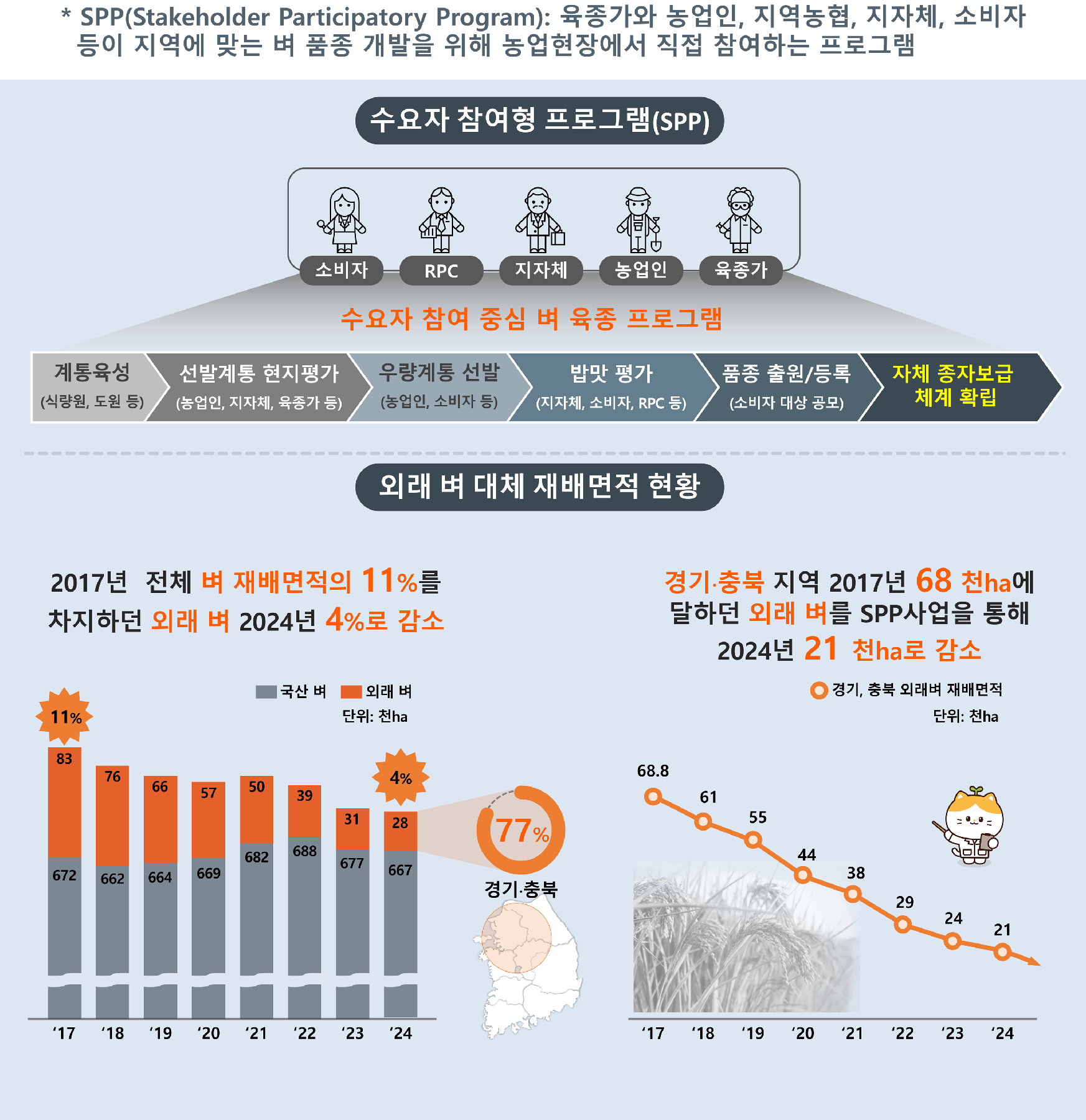Our Rice Developed with the People Reduces Foreign Rice Varieties by Over Half in Seven Years
Advancing Seed Sovereignty and Enhancing the Value of Local Rice Products by Replacing Foreign Rice Varieties

The Rural Development Administration (RDA) (Commissioner Kwon Jae-han) announced that the “Stakeholder Participatory Program (SPP) for Rice Variety Development” which began in 2016 has successfully reduced the cultivation area of foreign rice varieties in Korea from 11% in 2017 to around 4% in 2024*.
The cultivation area of foreign rice varieties decreased from 82952 hectares (11% of the total domestic rice cultivation area) in 2017 to less than 28000 hectares (around 4%) in 2024.
The Stakeholder Participatory Program (SPP) for Rice Variety Development is a field-oriented research initiative where local farmers breeders Rice Processing Complexes (RPCs) and consumers collaborate to develop distribute and manage rice varieties suited to regional characteristics.
To replace foreign rice varieties that despite being prone to pests and lodging had been cultivated for many years out of habit the RDA launched this research in Icheon Gyeonggi Province in 2016. The initiative later expanded to five additional local governments including Gimpo Ganghwa Pocheon and Yeoju*.
(2016) Icheon → (2020) Gimpo Ganghwa → (2021) Pocheon → (2023) Yeoju
By 2022 Icheon had fully replaced the foreign rice varieties Koshihikari and Akitakomachi used in its regional brand Imgeumnim Icheon Rice with the domestic varieties Haedul and Alchanmi.*
Cultivation area for Haedul in Icheon: (2019) 131 ha → (2020) 1020 ha; Fully replaced Koshihikari in 2020
Cultivation area for Alchanmi: (2020) 952 ha → (2022) 6050 ha; Fully replaced Akitakomachi in 2022
The success in Icheon has served as a model for other major foreign rice-growing regions including Pocheon Gimpo Ganghwa in Incheon and Jincheon and Cheongju in Chungcheongbuk-do. For example since 2022 Pocheon has replaced the foreign variety Koshihikari with Haedul and Alchanmi in its local brand Gichan Rice. This year Pocheon expanded the cultivation area of these varieties fourfold from the previous year to 2000 hectares (1 ha = 10000 m²). Additionally Ganghwa in Incheon developed the new variety Nadeulmi in 2022 and Gimpo introduced Hangadeuk in 2023 replacing 20% (1325 hectares) of the foreign rice cultivation area in these two regions.
Haedul and Alchanmi* are also being promoted beyond Gyeonggi Province to other regions like Chungcheongbuk-do where foreign rice varieties are widely cultivated further accelerating the replacement process. In Jincheon and Cheongju the domestic variety Alchanmi has replaced 75.4% of the Akitakomachi cultivation area in the production of Saenggeojincheon Rice and Cheongwon Saengmyeong Rice. Within three years of its introduction Alchanmi has become the most widely grown rice variety in Chungcheongbuk-do.
Cultivation area for Alchanmi in Chungcheongbuk-do: (2020) 0 ha → (2023) 9093 ha; No. 1 rice variety in 2023
These new domestic rice varieties* which are resistant to lodging and disease are not only superior in taste but also economically advantageous. Farmers find them easier to cultivate and benefit from reduced costs for pesticides and fertilizers.
Haedul (replacing Koshihikari) Alchanmi Nadeulmi Hangadeuk (replacing Akitakomachi)
According to an economic analysis by the RDA in 2021 farmers cultivating Alchanmi earned approximately 3 million KRW more per hectare than those growing the foreign variety Akitakomachi. Based on the projected cultivation area of Alchanmi in 2024 this would result in an annual economic impact of approximately 72.4 billion KRW. As the cultivation area for Alchanmi continues to expand and replace Akitakomachi the economic benefits are expected to increase further.
3.189 million KRW/ha (income increase compared to Akitakomachi) * 22700 ha (2024 Alchanmi cultivation area) ≒ 72.4 billion KRW
Through its New Technology Dissemination Project* the RDA is intensifying efforts to expand the number of top-quality rice production and supply hubs from 11 in 2020 to 50 nationwide by the end of this year.
Cultivation and supply of top-quality rice varieties to replace foreign varieties (2020-2023 30 hubs); Demonstration and expansion of high-quality new rice varieties (2023-2024 20 hubs)
In collaboration with regional institutions like the Gyeonggi Provincial Agricultural Research and Extension Services local governments and seed production agencies the RDA aims to reduce the cultivation area of foreign rice varieties to less than 10000 hectares by 2027.
The RDA is also working closely with related organizations* to provide a Comprehensive New Variety Custom Solution that supports the rapid adoption and expansion of newly developed rice varieties ensuring their stable establishment in the market.
Customized Cultivation Techniques for New Varieties (RDA local governments) - Seed Supply (RDA Agricultural Research and Extension Services Seed Production Agencies) - Variety Identification (RDA) - Quality Control (local governments RPCs) - Post-Management (RDA local governments) - Marketing (local governments)
Park Ki-do Director of the Central Crops Research Division at the RDA stated By developing and distributing superior domestic rice varieties through the Stakeholder Participatory Program we are ensuring safe farming practices even in the face of frequent weather-related disasters and enhancing the value of regional rice brands. He added We will continue our efforts to boost farm income and regional development while strengthening Koreas sovereignty over its rice seeds.
Website: : http://www.wip-news.com/news/articleView.html?idxno=24595
